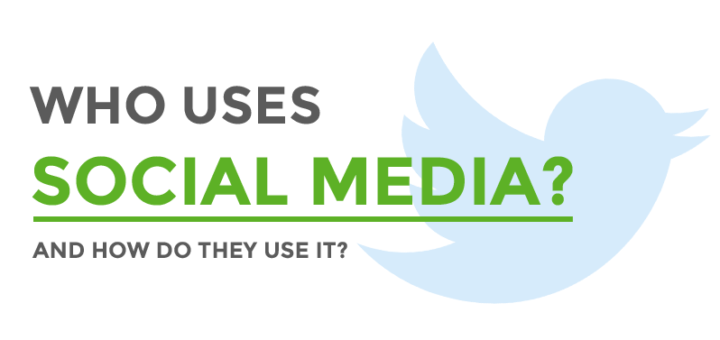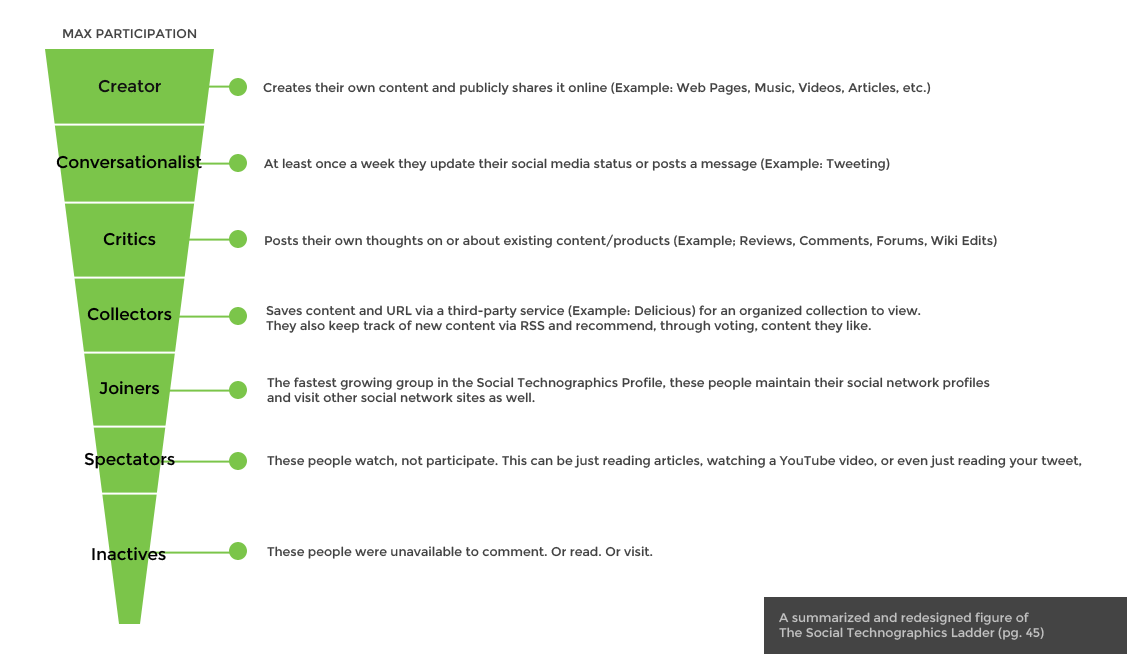The People Who Use Social Media

Chapter 3 of “Groundswell: Winning in a World Transformed by Social Technologies” discusses the type of people who use social media and how they use it. According to The Social Technographics Ladder (Bernoff & Li, 2011, p.43), which has been recreated for this blog post, there are seven different types of users.

This of course was the central theme in the chapter and, to myself, the most interesting. Throughout we see that using this ladder of groups, their participation varied not only by their location, but also their political views, interests, impulses, and peer pressures (Bernoff & Li, 2011, p.60-61).
Age is also important. The examples used US Adults as their markings in examples but was also sure to state everyone, younger or older, used it. The chapter shows the percentage of US adult users as their markings in their examples. What about the young adults that grow up through an online world?
The Participation Advantage
 According to a 2009 Social Technographics analysis of 18-24 year olds (seen to the right), you can see that joiners are one of the highest groups shown. It corresponds to the book in saying that joiners, for US adults, are one of the fastest growing segments. We also see a majority of people participating rather than sitting back. So, why is this important and why is this interesting?
According to a 2009 Social Technographics analysis of 18-24 year olds (seen to the right), you can see that joiners are one of the highest groups shown. It corresponds to the book in saying that joiners, for US adults, are one of the fastest growing segments. We also see a majority of people participating rather than sitting back. So, why is this important and why is this interesting?
I consider myself a creator. I constantly make content through YouTube, Twitter and other social networks as well and looking from the eyes of a creator there is a massive opportunity that has been taken advantage of. More people are participating now, whether it be in the form of comments or keeping an eye on their favourite people or brands. It is however those people and brands that have seen the opportunity. For example, look at this common tweet. People often now take advantage of this increase in participation by invoking it for their own appeal through the use of retweets, follows and and likes. Heck, even I take advantage of it by asking a question of the day in my own videos. I do this in part because it gets viewers talking and more likely to stick with me after a series concludes; even if the question is “what is your favourite dessert?” (confetti cake by the way).
The Business Approach
The Social Technographics profile can also be useful in a business environment. As a freelance website developer, my target market is broad. Generally I work for small businesses and individuals who might need help with a blog. However, from a social media aspect, I can narrow down profiles to being joiners and collectors. While I’ve fallen behind recently on posting my own industry recommendations and interests via Twitter, when I do, I see that people are keeping it for later (collecting) and liking/retweeting those posts (joining). There’s not really a strong participation that I’ve taken advantage of. It does however teach me that I can share industry thoughts and even share my own projects to have better appeal; I just have to be consistent.
There are seven groups that are part of Social Technographic Profile set. Creators, conversationalists, critics, collectors, joiners, spectators and inactives. The amount of inactives is low, regardless of if it’s strictly US adults or young adults, and participation is more inticing now more than ever. If taken advantage of, it allows for the creation of communities, the spread of your own brand and more. Regardless of the industry, social media plays a part in how we advertise ourselves. A web developer can create interest in their projects. A non-profit can create love and invoke sharing to make everyone feel involved, even if it’s just the press of a retweet button.
SOURCES
Bernoff, J., Li, C. (2011). Groundswell: Winning in a world transformed by social technologies (expanded and revised edition). Boston, MA: Harvard Business School Publishing

